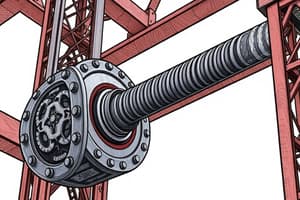Podcast
Questions and Answers
Which of the following organizations is known for its steel specifications?
Which of the following organizations is known for its steel specifications?
- National Aeronautics and Space Administration (NASA)
- Federal Bureau of Investigation (FBI)
- American Iron and Steel Institute (AISI) (correct)
- Central Intelligence Agency (CIA)
In a steel specification number, what does the '1XXX' designation indicate?
In a steel specification number, what does the '1XXX' designation indicate?
- Chromium Steel
- Nickel steel
- Molybdenum steel
- Plain carbon steel (correct)
What does '11XX' indicate in a steel specification number?
What does '11XX' indicate in a steel specification number?
- Plain carbon steel with greater sulfur content for free-cutting (correct)
- Nickel steel with added chromium
- Manganese Steel
- Plain carbon steel with added lead
In SAE steel grades, what does '2XXX' indicate?
In SAE steel grades, what does '2XXX' indicate?
What is the SAE number designation for chromium steel?
What is the SAE number designation for chromium steel?
What information do the last two digits of a four-digit SAE steel specification number provide?
What information do the last two digits of a four-digit SAE steel specification number provide?
Which SAE number represents chromium-vanadium steel?
Which SAE number represents chromium-vanadium steel?
What is the approximate carbon content in SAE 1030 steel?
What is the approximate carbon content in SAE 1030 steel?
What does an increase in carbon content typically do to steel strength?
What does an increase in carbon content typically do to steel strength?
In the AISI steel numbering system, what does the prefix 'B' indicate?
In the AISI steel numbering system, what does the prefix 'B' indicate?
What is a common application for 10XX series steel with 10-20 points of carbon?
What is a common application for 10XX series steel with 10-20 points of carbon?
What does the prefix 'E' in the AISI steel numbering system signify?
What does the prefix 'E' in the AISI steel numbering system signify?
What property does higher sulfur content impart to 11XX series steels?
What property does higher sulfur content impart to 11XX series steels?
Which of the following is a typical application for steels containing 30-55 points of carbon?
Which of the following is a typical application for steels containing 30-55 points of carbon?
What treatments are applied to high-carbon steels (60-95 points) to achieve high hardness??
What treatments are applied to high-carbon steels (60-95 points) to achieve high hardness??
Which of the following is NOT a typical application for steels with 10–20 points of carbon?
Which of the following is NOT a typical application for steels with 10–20 points of carbon?
Flashcards
AISI and SAE
AISI and SAE
Organizations that created widely used steel specifications.
SAE '1XXX'
SAE '1XXX'
Indicates plain carbon steel.
SAE '11XX'
SAE '11XX'
Indicates plain carbon steel but better machinability.
SAE '2XXX'
SAE '2XXX'
Signup and view all the flashcards
Last 2 digits in SAE steel number
Last 2 digits in SAE steel number
Signup and view all the flashcards
AISI Prefix 'C'
AISI Prefix 'C'
Signup and view all the flashcards
AISI Prefix 'E'
AISI Prefix 'E'
Signup and view all the flashcards
AISI Suffix 'H'
AISI Suffix 'H'
Signup and view all the flashcards
5XXX
5XXX
Signup and view all the flashcards
61XX
61XX
Signup and view all the flashcards
Effect of ↑ Carbon in Steel
Effect of ↑ Carbon in Steel
Signup and view all the flashcards
Typical use for 10-20 carbon steel
Typical use for 10-20 carbon steel
Signup and view all the flashcards
Benefit of ↑ Sulfur in 11XX steel
Benefit of ↑ Sulfur in 11XX steel
Signup and view all the flashcards
What makes 1141 steel unique?
What makes 1141 steel unique?
Signup and view all the flashcards
Use for 20-30 carbon steel
Use for 20-30 carbon steel
Signup and view all the flashcards
Use for 60-95 carbon steel
Use for 60-95 carbon steel
Signup and view all the flashcards
Study Notes
- American Society for Testing Materials (ASTM), Society of Automotive Engineers (SAE), and American Iron and Steel Institute (AISI) all have widely used steel specifications.
- AISI uses prefixes B, C, D, and E to indicate the manufacturing method of carbon grades.
- The first digit (or first two digits) in a steel specification number represents the type of steel.
- '1XXX' in a steel specification number indicates plain carbon steel.
- '11XX' indicates plain carbon steel with greater sulfur content for free-cutting.
- '2XXX' indicates nickel steel.
- The last two digits in a four-digit SAE steel specification number represent the approximate or average carbon content in hundredths of a percent.
- SAE 1030 or AISI C1030 steel has about 0.30% carbon content.
- The prefix 'B' in the AISI steel numbering system indicates acid Bessemer steel.
- The prefix 'C' in the AISI steel numbering system indicates basic open-hearth carbon steel.
- The prefix 'D' in the AISI steel numbering system indicates acid open-hearth carbon steel.
- The prefix 'E' in the AISI steel numbering system indicates electric-furnace steel (usually alloy).
- A 'B' in the middle of an AISI steel specification number indicates the presence of boron.
- An 'L' in the middle of an AISI steel specification number indicates the presence of lead.
- An 'H' at the end of an AISI steel specification number indicates it was bought on a hardenability specification.
- The SAE number for plain carbon steel is 10XX.
- The SAE number for free-cutting steel is 11XX.
- The SAE number for manganese steel is 13XX.
- The SAE number for boron steel is 14XX.
- The SAE number for nickel steel is 2XXX.
- The SAE number for nickel-chromium steel is 3XXX.
- The SAE number for heat and corrosion-resistant nickel-chromium steel is 30XXX.
- The SAE number for molybdenum steel is 4XXX.
- The SAE number for molybdenum-chromium steel is 41XX.
- The SAE number for molybdenum-chromium-nickel steel is 43XX.
- The SAE number for molybdenum-nickel steel is 46XX.
- The SAE number for molybdenum-chromium-nickel steel (another variant) is 47XX.
- The SAE number for molybdenum-nickel steel (another variant) is 48XX.
- The SAE number for chromium steel is 5XXX.
- The SAE number for heat and corrosion-resistant chromium steel is 514XX.
- The SAE number for another variant of chromium steel is 53XX.
- The SAE number for chromium-vanadium steel is 61XX.
- The SAE number for nickel-chromium-molybdenum steel is 81XX.
- The SAE number for silicon-manganese steel is 92XX.
- The SAE number for another variant of nickel-chromium-molybdenum steel is 93XX.
- The SAE number for nickel-chromium-molybdenum steel, except 92XX, is 94XX.
- The SAE number for another variant of nickel-chromium-molybdenum steel is 95XX.
- Table AT 7 generally shows that steel strength increases with carbon content, while ductility decreases.
- Steel with 10–20 points of carbon in the 10XX group are typically used for tubing, forgings, pressed-steel parts, screws, rivets, and carburized case-hardened parts.
- Higher sulfur content in the 11XX group of steels makes the steel free-cutting and suitable for automatic screw machines.
- Open-hearth steels identified by the symbol 'C' are preferred for case hardening in the AISI system.
- 1141 steel contains more manganese and is heat-treatable for improved mechanical properties, setting it apart from other 11XX steels.
- 11XX steels are generally not suitable for welding.
- General-purpose steels with 20–30 points of carbon are used for forged and machined parts, screws, boiler plate, and structural steel.
- Steels with 30–55 points of carbon are commonly used for miscellaneous forged and machined parts, shafts, and frequently heat-treated for better properties.
- Cold-finished steels with 30–55 points of carbon are used for shafting because they offer improved mechanical properties through heat treatment.
- Steels with 60–95 points of carbon are typically used for tools, springs, and high-strength applications.
- High-carbon steels (60–95 points) are usually heat treated to achieve high hardness, often to a Brinell hardness of 375 or higher.
Studying That Suits You
Use AI to generate personalized quizzes and flashcards to suit your learning preferences.



